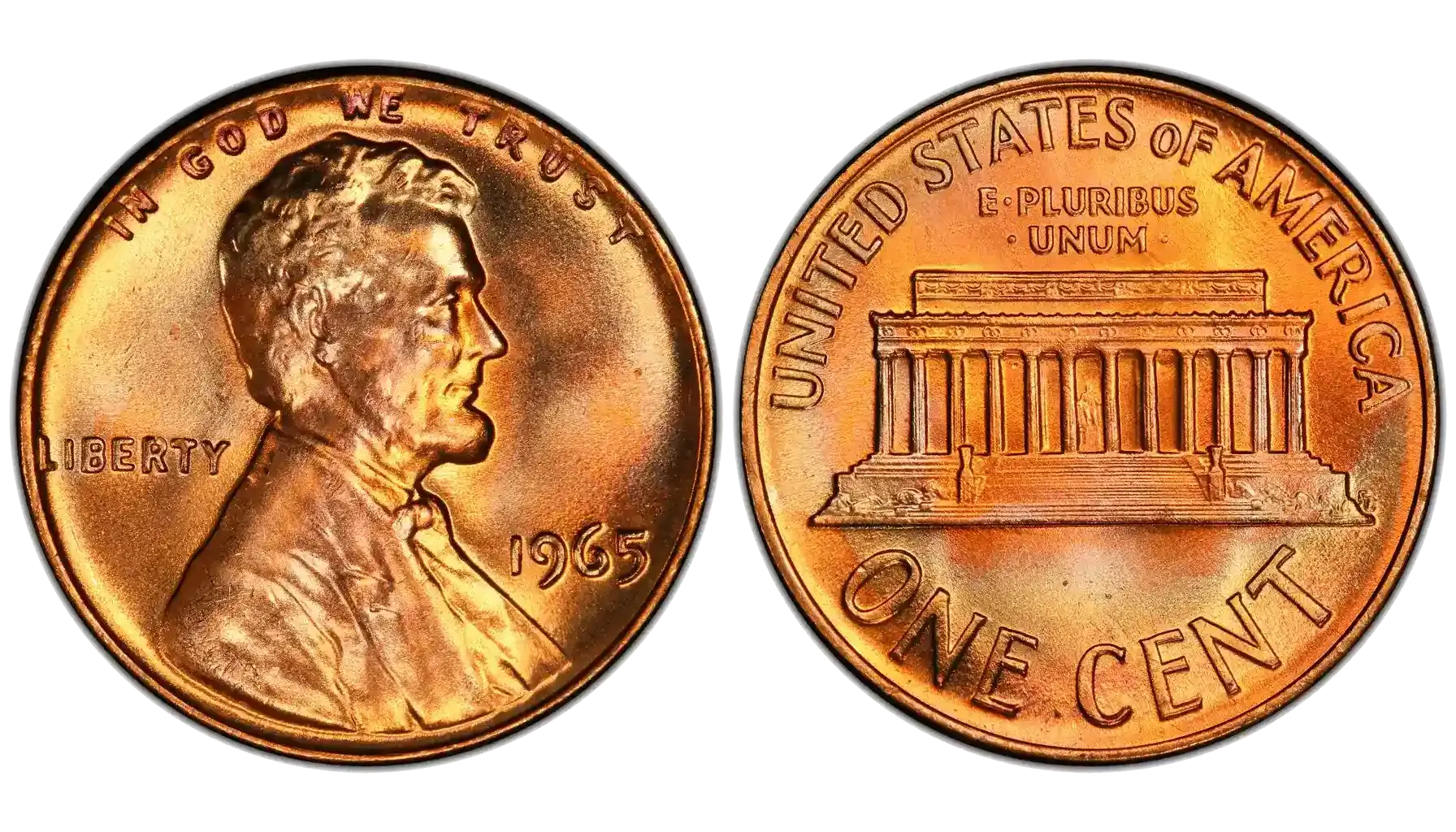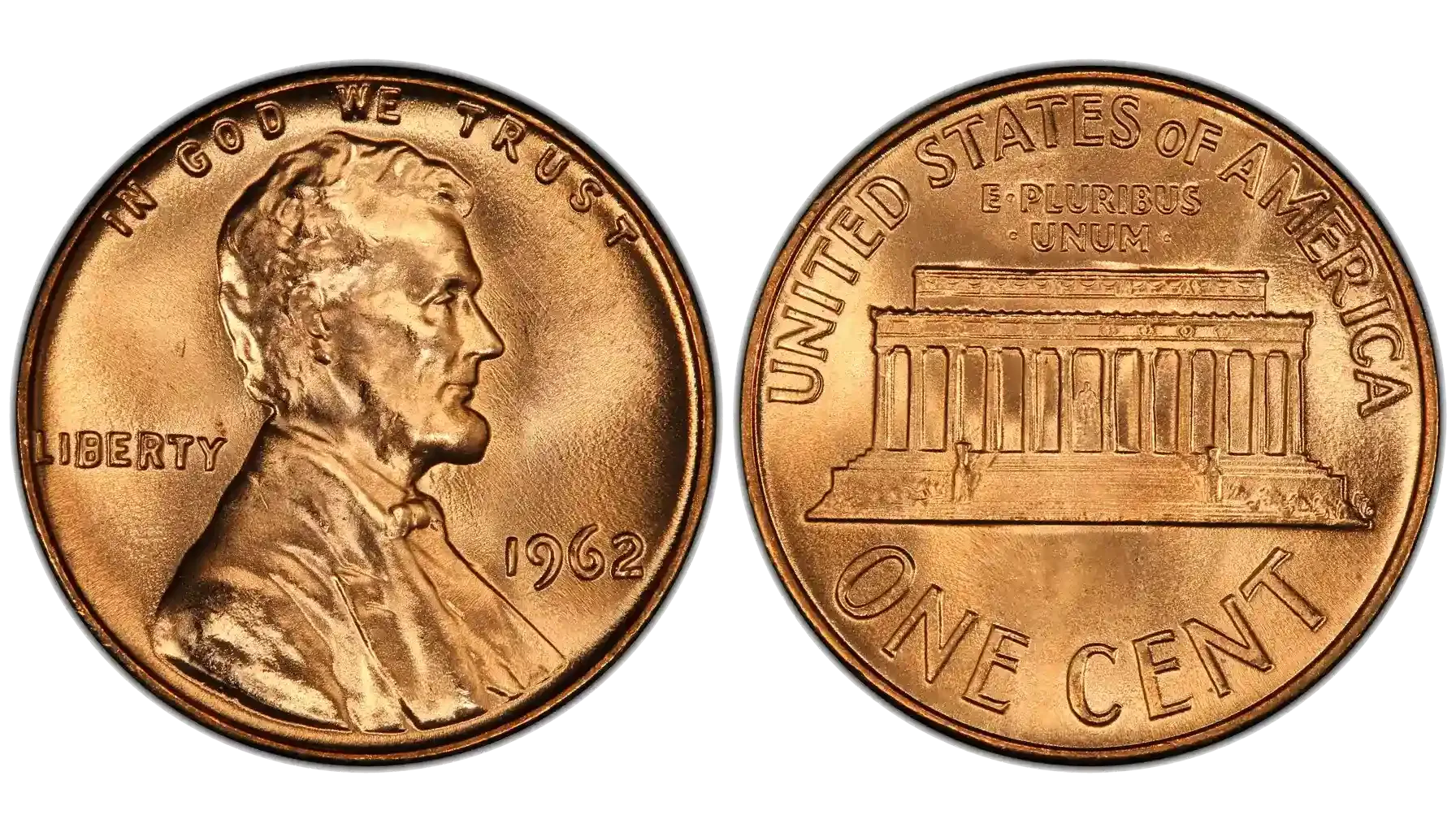Contents:
The Roosevelt dime series began in 1946 as a tribute to President Franklin D. Roosevelt and his fight against polio. By 1965, silver was removed from circulating dimes, and they were made from clad layers of copper and nickel. But by 1969, something unusual happened.
Among the millions of dimes struck that year, two rare and highly valuable varieties were created:
No-S Proofs – mistakenly struck without a mint mark
Doubled Die Obverses – errors showing doubled text and numbers
But how much is a 1969 dime worth today? And why is it important to identify the coins?
Feature | Details |
Denomination | 10 Cents |
Obverse Design | Portrait of Franklin D. Roosevelt |
Reverse Design | Torch flanked by olive branch and oak |
Designer | John R. Sinnock (obverse & reverse) |
Composition | Copper-Nickel Clad (75% Cu, 25% Ni) over pure copper core |
Diameter | 17.91 mm (0.705 inches) |
Weight | 2.27 grams (0.08 oz) |
Edge | Reeded |
Mint Marks | None (Philadelphia = 1969 no mint mark dime), D (Denver), S (San Francisco – Proof only) |
Mintage | P: 145,790,000 D: 563,323,870 S (Proof): 2,934,631 |
Mint Marks and the Value of 1969 Dime
1969 Dime Value No Mint Mark
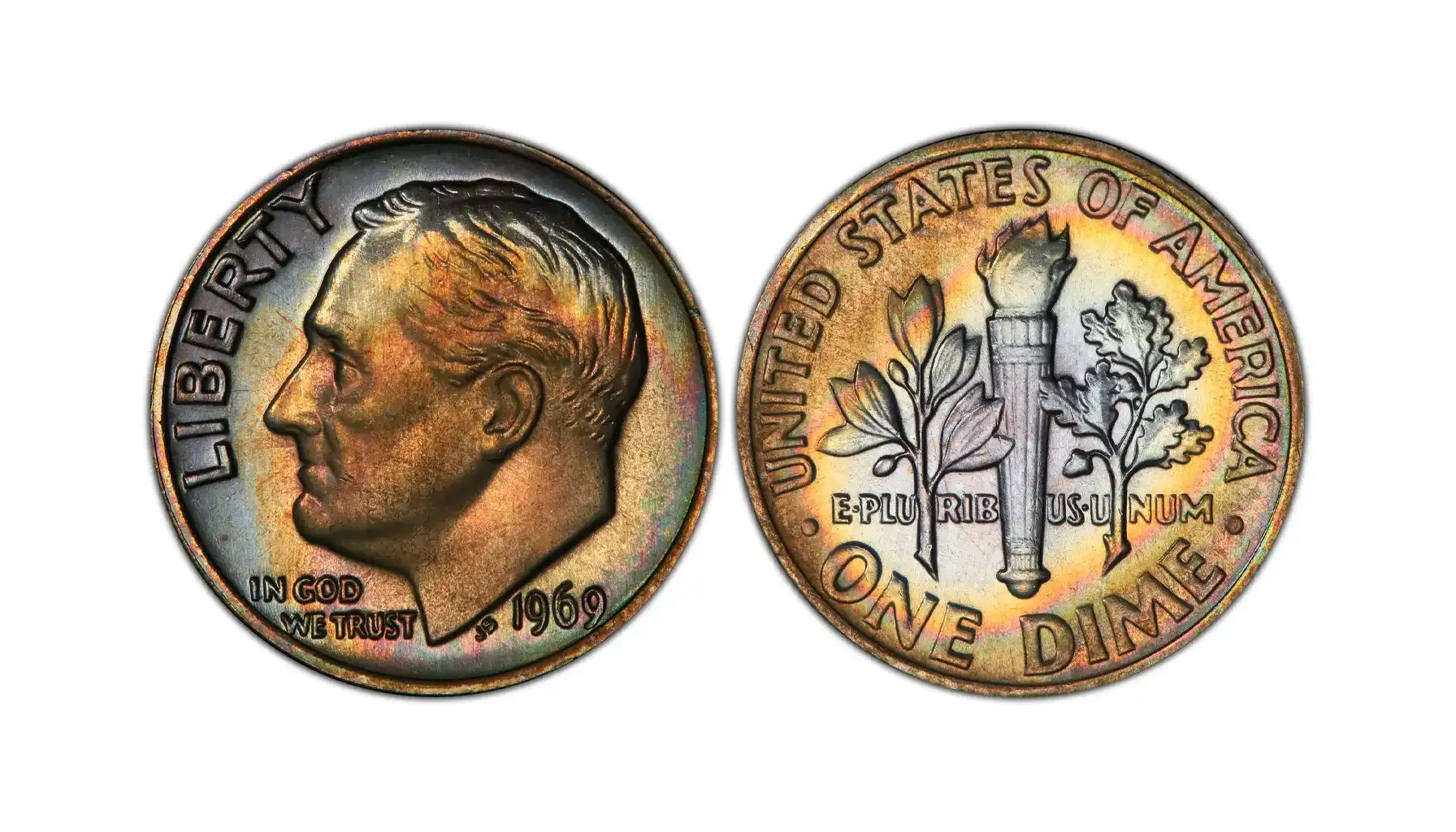
Mintage: 145,790,000
Mint Mark Location: None (standard for Philadelphia coins before 1980)
Type: Business strike
1969 Dime No Mint Mark Value in MS65: ~$5–$20
Notable Varieties: Possible doubled die obverses (DDO)
If you have a 1969 dime with no mint mark that looks proof-like (mirror finish), it might be a No-S Proof, which is rare and valuable.
1969 D Dime Value
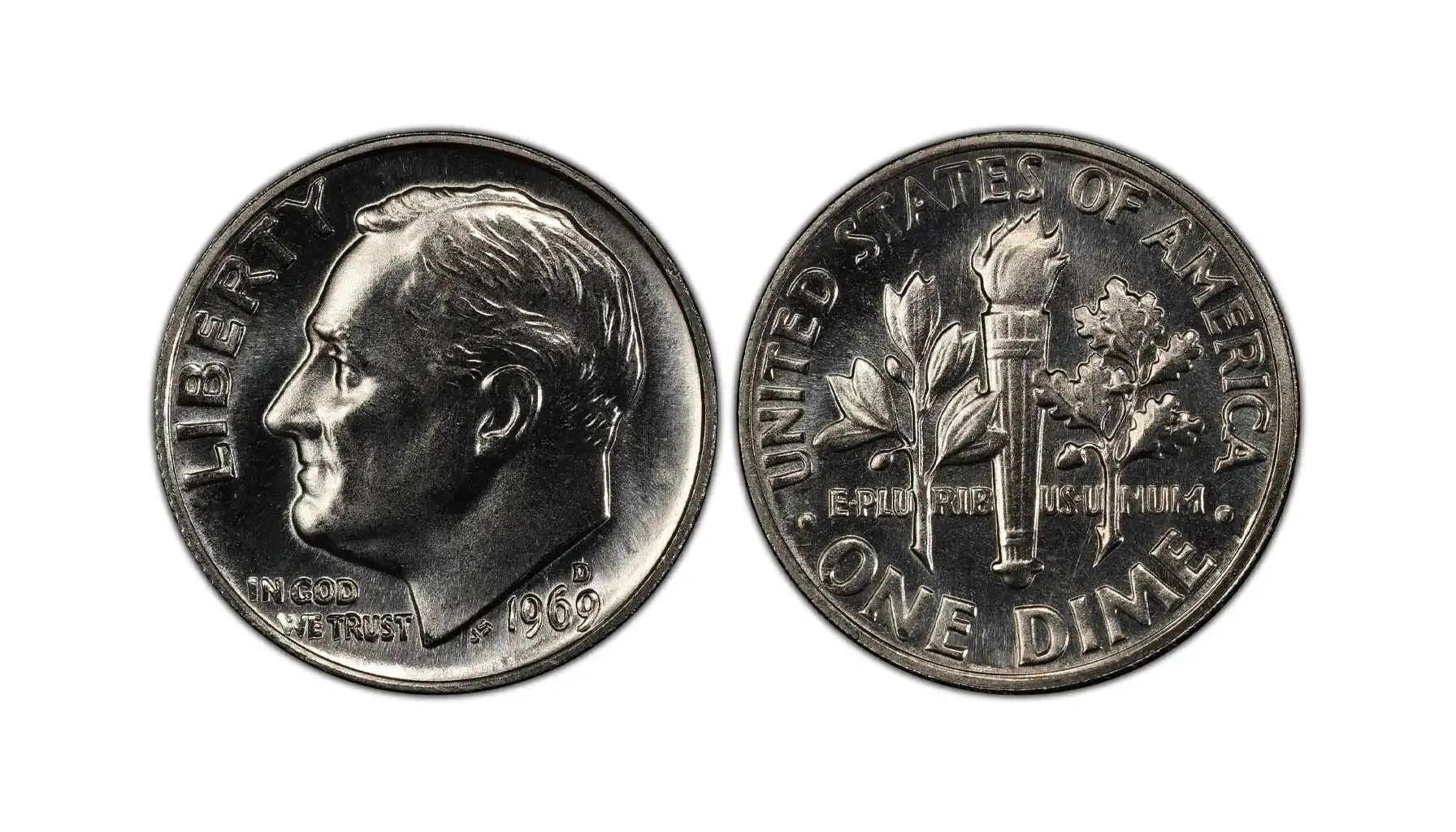
Mintage: 563,323,870
Mint Mark Location: To the left of the torch, above the “E” in ONE
Type: Business strike
1969 Dime D Mint Mark Value in MS65: ~$3–$15
Notable Varieties: Some minor errors known, but no major doubled dies recorded.
High-grade Denver pieces with Full Bands (FB/FT designation) can command a premium.
1969 S Dime Value – Proof Coins Only

Mintage: 2,934,631
Mint Mark Location: Below the year on the obverse
Type: Proof only – not released for circulation
What Is a 1969 Dime Worth in PR65–PR69: ~$2–$10 (regular); $25,000+ for No-S Proof
1969 Dime Error List with Pictures
1969 No-S Proof (Missing Mint Mark Error)
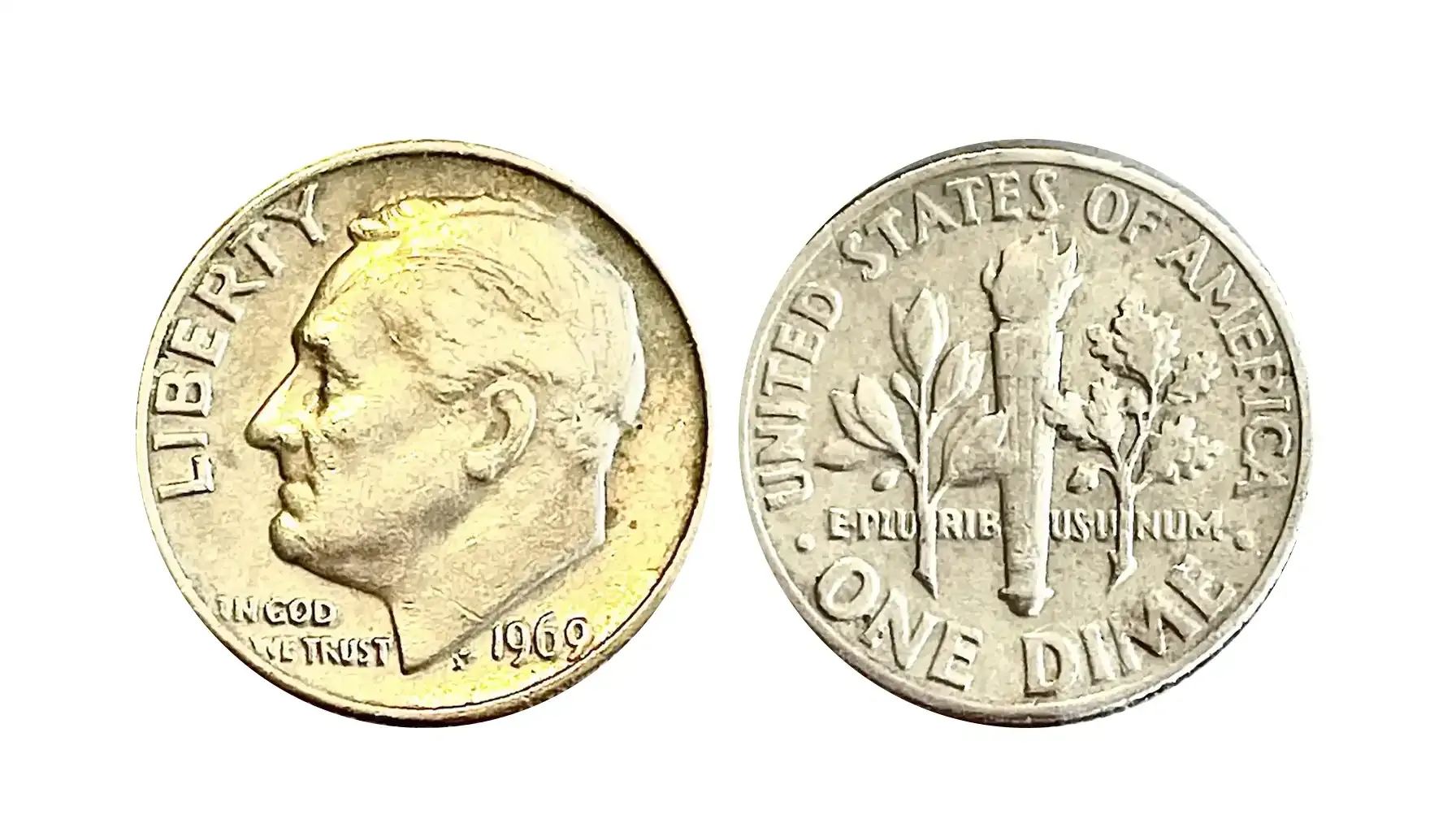
A proof coin struck at the San Francisco Mint that was mistakenly made without the “S” mint mark. All proof coins from San Francisco were supposed to bear an “S” below the date. A missing mint mark means the die used was never punched with the “S”—a major minting oversight.
How to Identify:
Deep mirror-like finish (proof strike)
No mint mark under the date
Sharp, frosted design elements
Available only in proof sets
Why It’s Valuable:
Fewer than a dozen examples are confirmed to exist.
One of the rarest modern U.S. coin errors.
Estimated 1969 S Dime Worth without a Mint Mark: $20,000–$35,000+ depending on condition (PR66–PR69)
Doubled Die Obverse (DDO)
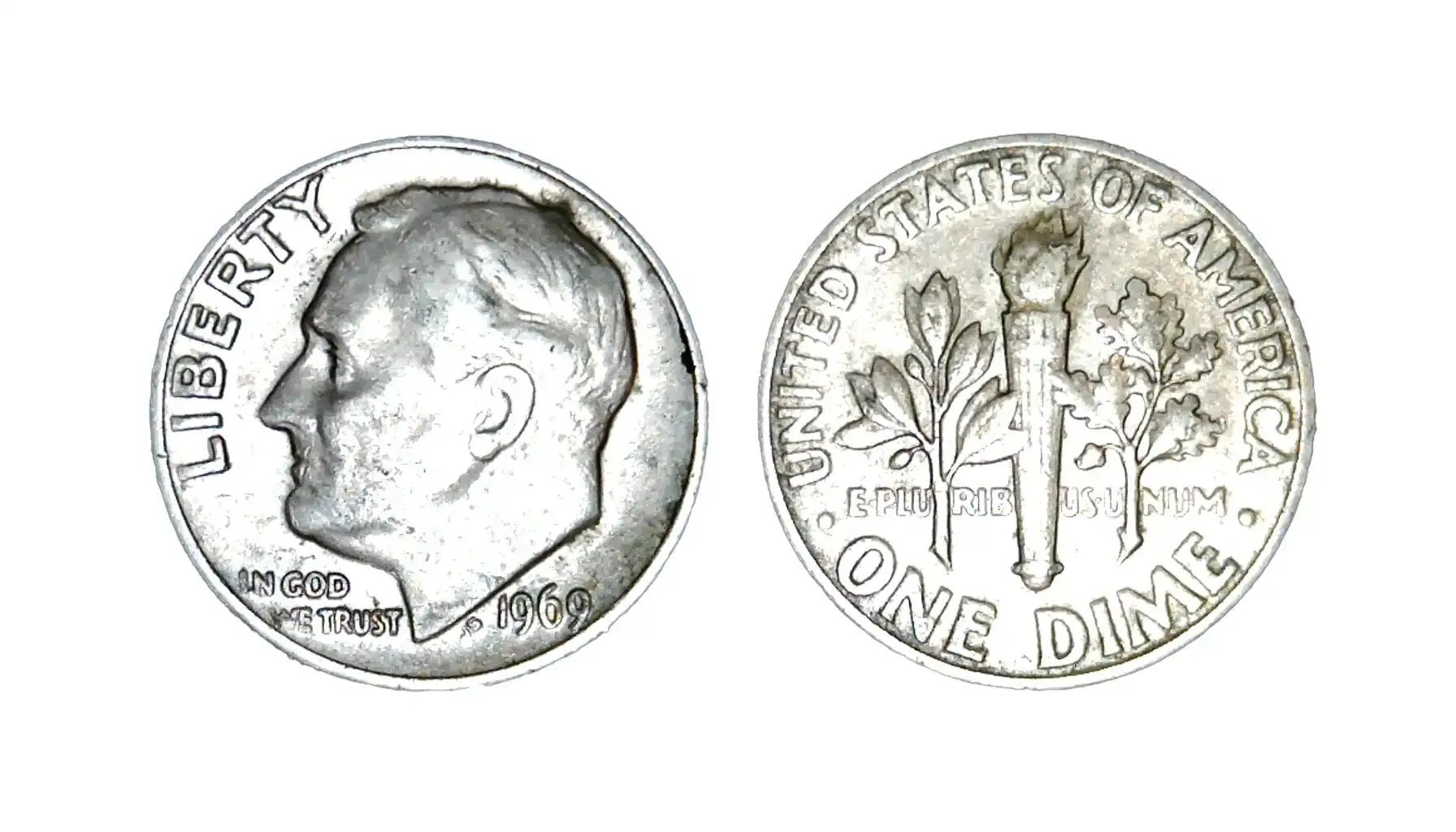
Another example of 1969 dime errors is where the die was imprinted twice with a slightly misaligned design. This causes key inscriptions on the obverse (front) to appear doubled, especially visible on the lettering and numbers.
Where to Look:
LIBERTY – noticeable doubling on each letter
IN GOD WE TRUST – bold doubling
Date – digits show slight or heavy offset
Why It’s Valuable:
True DDOs are distinct from machine doubling and highly collectible.
Clean, high-grade examples are rare and stand out at auctions.
Is a 1969 Dime Worth Anything in This Case?
$100 in circulated grades
$400–$1,000+ in uncirculated MS65+ condition
Die Clash
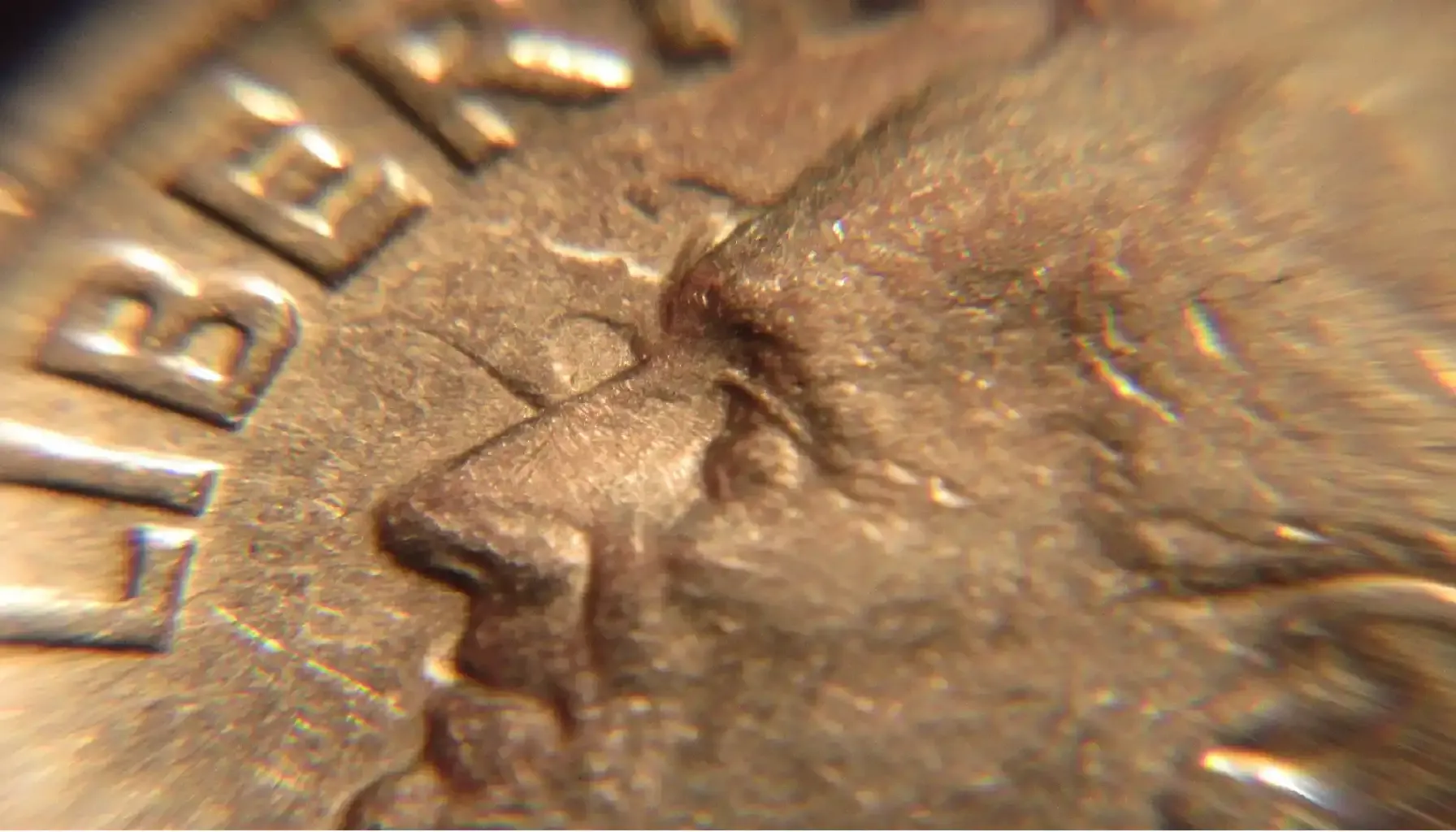
Occurs when the coin dies strike each other without a planchet in between, leaving ghost-like images of the reverse design on the obverse die (and vice versa).
How to Spot:
Strange impressions or outlines of torch and branches on Roosevelt’s face
Misplaced lines that don't match normal detail
Estimated Value: $20–$75 depending on clarity and grade
Off-Center Strike
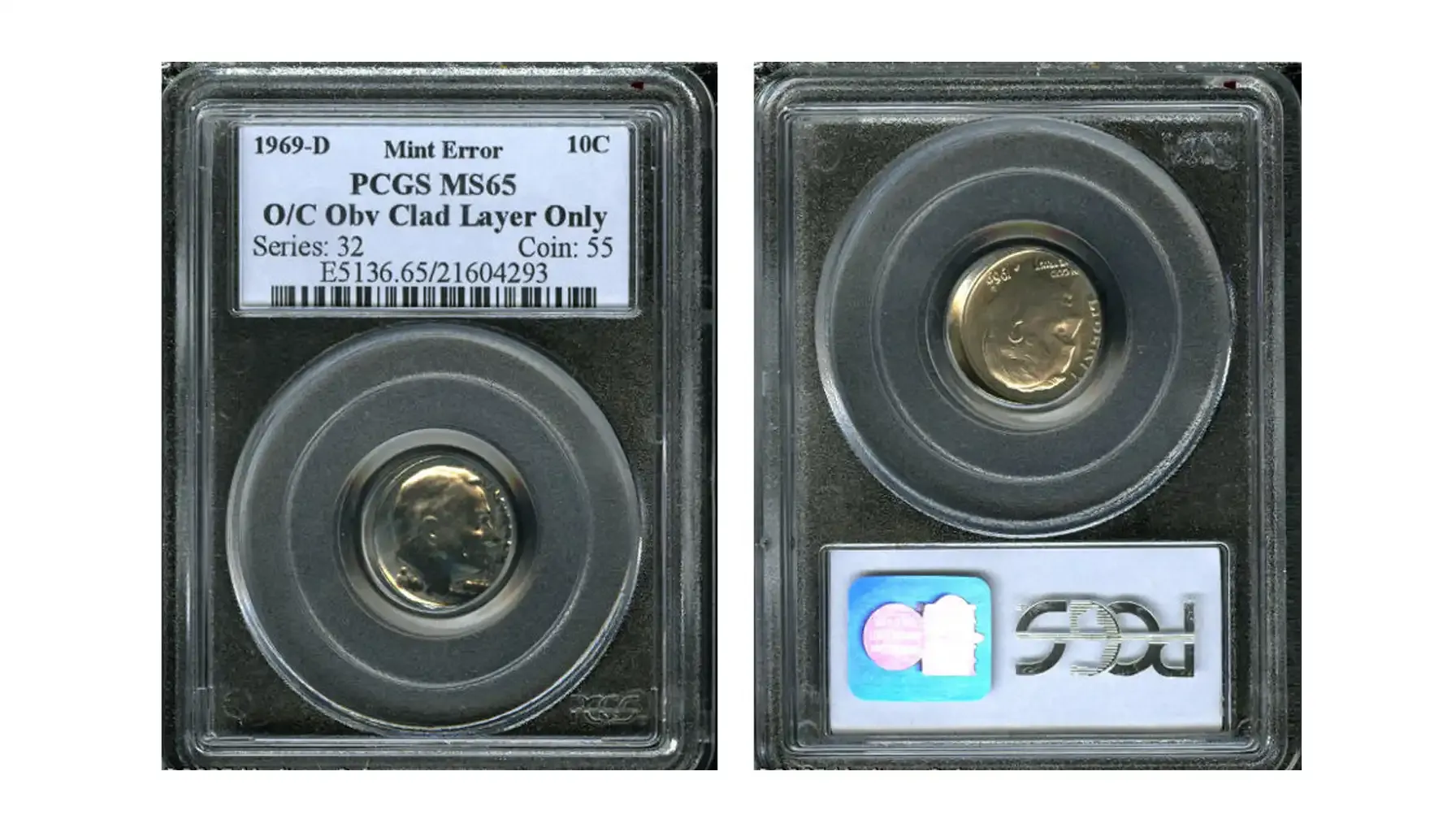
The coin is not properly aligned during striking, resulting in part of the design being shifted off-center. The more dramatic the offset, the more desirable the coin.
How to Spot:
Partial blank planchet visible
Incomplete rim and design
At least 5–10% off-center to carry value
Estimated Value of a 1969 Dime:
Minor: $15–$30
Major with full date: $50–$150+
Clipped Planchet

A piece of the metal planchet was incomplete or clipped during cutting, resulting in a curved or irregular missing portion on the finished coin.
How to Spot:
Smooth, crescent-shaped or straight missing area on the coin's edge
Full rim opposite the clip is typically intact
Estimated Dime 1969 Value: $25–$100 depending on the size and clarity of the clip
Composition Myths
Not all coins that look silver actually are silver—and the 1969 Roosevelt one is a perfect example of this confusion. Many new collectors and curious holders believe their coin might be made of precious metal simply because of its shine, color, or age.
Myth #1: All 1960s Dimes Are Made of Silver
Only those dated 1964 or earlier contain 90% silver. In 1965, the U.S. Mint switched to a copper-nickel clad composition, which continued through 1969 and beyond. Therefore, the 1969 dime silver content is 0%.
Date | Composition |
1946–1964 | 90% Silver, 10% Copper |
1965–Present | Copper-Nickel Clad |
Myth #2: A Shiny Coin Means It’s Silver
Shine alone is not an indicator of a 1969 silver dime. A well-preserved clad one or even a proof version can appear bright and lustrous, but the composition remains the same. Only coins from 1964 or earlier should be tested for silver content.
Moreover, there are no 1969 gold dime specimens.
Myth #3: Proof Dimes Always Have Higher Metal Value
1969-S proof ones are visually appealing, but their metal content is identical to regular dimes—copper-nickel clad. They were never minted in silver for that year. Proofs are valuable only when rare (like the No-S error), not because of their metal.
If you’re unsure about the metal content of your coin, never guess based on color or shine. Always check the date, edge, and weight—and when in doubt, use tools like the Coin ID Scanner app to confirm authenticity and composition.
1969 Dimes Worth Money – Recent Auction Highlights
Variety | Grade | Auction House | Sale Price | Date of Sale |
1969 No-S Proof | PR68 DCAM | Heritage Auctions | $31,625 | Jan 2021 |
1969 No-S Proof | PR67 CAM | Stack’s Bowers | $25,850 | Oct 2019 |
1969 Doubled Die Obverse (DDO) | MS65 | eBay (Verified Seller) | $845 | Aug 2023 |
1969 D Roosevelt Dime | MS67 FB | GreatCollections | $182 | Mar 2022 |
1969 Roosevelt (No Error) | MS66 | Heritage Auctions | $90 | Jun 2020 |
1969-S Proof (Standard) | PR69 DCAM | Stack’s Bowers | $48 | Feb 2024 |
How to Store a 1969 Dime Worth Money (and Other Valuable Coins)
Protecting your coins is essential to maintaining (and increasing) their value—especially if you own rare specimens from the 1969 D dime error list with pictures. Improper storage can lead to tarnish, scratches, or corrosion, all of which reduce market value.
1. Use the Right Holders
Storage Type | Best For | Pros | Cons |
2x2 Cardboard Flips | Budget collections | Cheap, writable, widely used | May scratch coins if not handled carefully |
Plastic Flips (PVC-free) | Short- to mid-term storage | Clear view of coin; no adhesives | Must ensure they’re PVC-free |
Airtight Capsules | High-value or proof coins | Excellent protection, moisture seal | More expensive |
Slabs (Certified Holders) | Graded and authenticated coins | Best protection; market-recognized | Requires submission to grading service |
2. Control Temperature and Humidity
Store coins in a cool, dry place (ideal range: 65–70°F / 18–21°C with <50% humidity).
Avoid areas with frequent temperature shifts (e.g., basements, attics).
Use silica gel packs or a dehumidifier to reduce moisture risk.
3. Handle With Care
Always handle coins by the edges, never the faces.
Wear cotton or nitrile gloves if working with proofs or uncirculated coins.
Never clean coins—cleaning damages surfaces and lowers value.
4. Organize and Document
Use coin binders, labeled boxes, or digital tracking apps to catalog your collection.
Note key details: variety, grade, purchase source, estimated 1969 P dime value (as well as other mint marks).
Apps like Coin ID Scanner allow you to digitally store your collection.
5. Secure Your Collection
Store valuable coins in a locked drawer, safe, or safety deposit box.
For high-value coins (e.g., No-S Proofs, or those from the 1969-D dime error list), consider insurance coverage through your homeowner’s policy or a numismatic insurer.

FAQs
Are 1969 Roosevelt Dimes Worth Grading?
Yes, but only under specific conditions.
Most circulated specimens are not worth the cost of third-party grading. However, grading is recommended if your coin has one of the following features:
Proof-like appearance with no mint mark (possible No-S error)
Clear doubled die on the obverse
Exceptional strike with Full Bands (FB/FT)
High uncirculated grade (MS66 or better)
Tip: Submit coins only if their value post-grading exceeds $100, or if authentication is necessary.
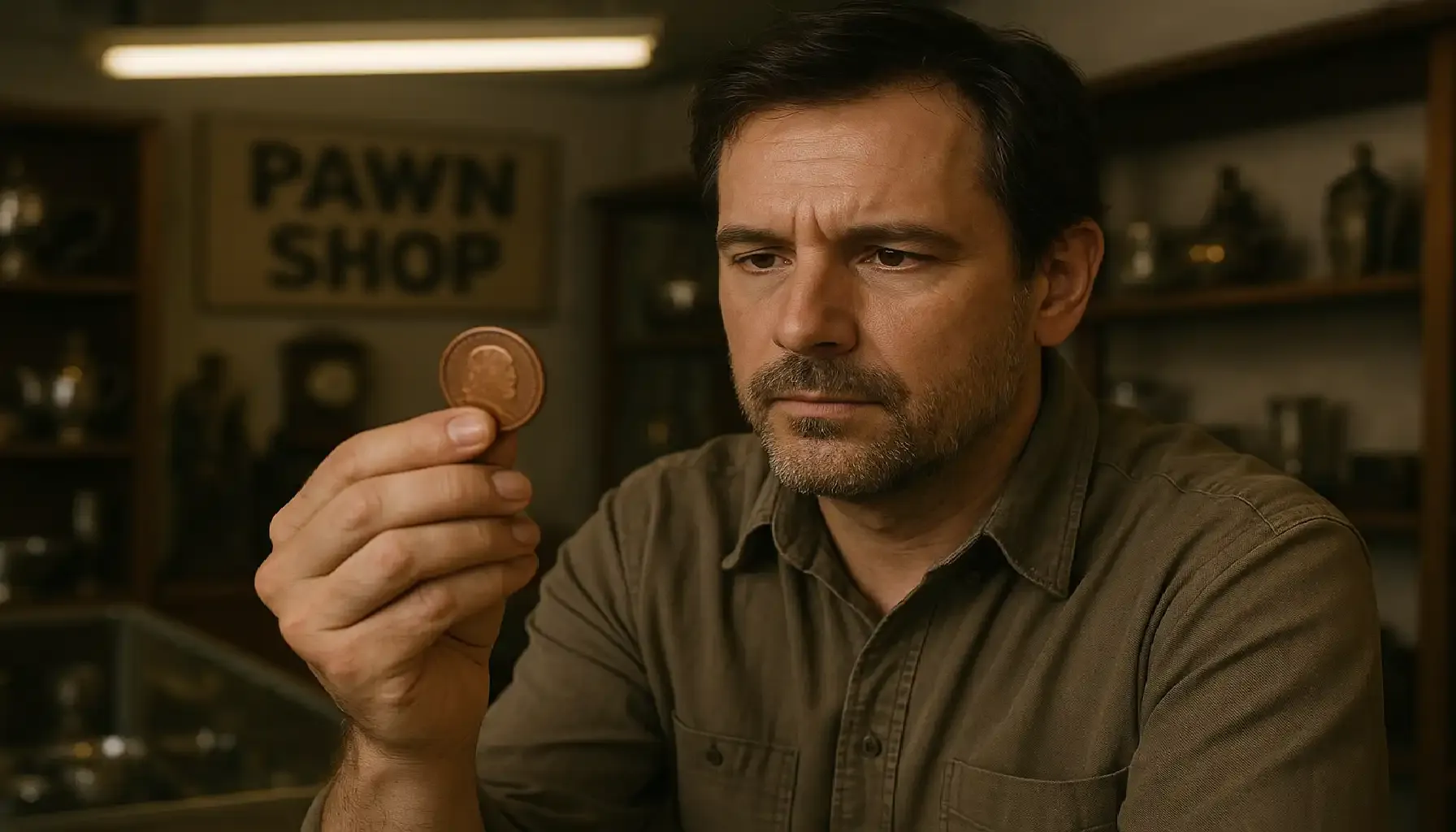
Can I Find a Rare 1969 Copper Dime in Pocket Change Today?
It’s unlikely—but not impossible.
Most valuable varieties, like the No-S proof, originated in proof sets and were not released into circulation. However, DDO varieties and high-grade business strikes could still be out there.
Your opportunities:
Estate sales and antique shops
Old proof or mint sets
Bulk rolls from banks or dealers
What Are Full Bands (FB/FT), and Why Do They Matter?
“Full Bands” (also known as Full Torch or FT) refers to the clarity and completeness of the horizontal lines on the torch on the reverse.
To qualify for the FB/FT designation, these bands must be fully struck and unbroken.
Designation | Location | Impact on Value |
FB (PCGS) | Horizontal torch bands | Can double or triple market value |
FT (NGC) | Same as FB | Same value boost as FB |
Coins with FB/FT are typically found only in higher grades (MS66+), and grading services will note this on the slab.
How Can Coin ID Scanner Help?
Coin ID Scanner makes it easy to spot valuable coins, e.g., 1969 D dime errors, in seconds:
Snap a photo to instantly identify a piece.
Get real-time value estimates based on grade and recent sales.
Identify key features.
Organize your collection digitally.

